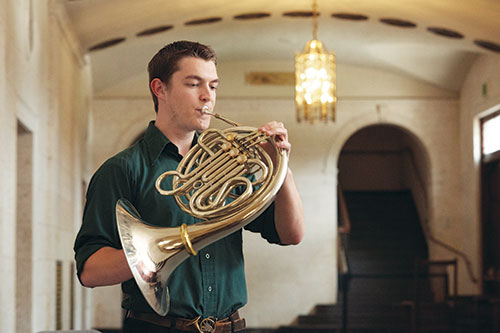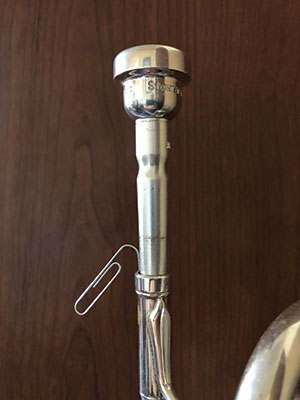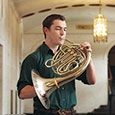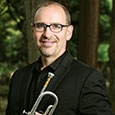The very thought of teaching lip slurs on brass instruments can strike fear into the hearts of even the most seasoned educator. Confronting the mystical overtone series, finding creative ways to explain the process, and even knowing what exercises to prescribe can be daunting tasks. However, this technique is one of the most crucial aspects of playing a brass instrument, and should be a part of every brass student’s daily routine.
Ultimately, the primary goal for all brass players is to sound great despite the technical or physical challenges presented in the repertoire. My students have come to expect this trick question: “Why do we study (insert topic – flexibility, articulation, dexterity, range)?” The correct response is to sound great doing whatever repertoire we are working on. We should consistently pursue lip flexibility with our students. Moving across the range of the instrument with a limited number of valves or slide positions means that brass players rely heavily on the strength of the embouchure and the efficiency of the airstream. Working on flexibility exercises with developing brass players advances this mission quite effectively.
For sake of clarification, a lip slur on a brass instrument requires moving from one partial (or note) on the overtone series to another note with the same fingering or slide position. Admittedly, the trombone concerns surrounding this topic require a separate article, but generally speaking, this challenge is common across all brass instruments.
While it may seem obvious, this process is referred to as a lip slur and not a tongue slur for good reason. Slurring cleanly from one note to another requires a free-flowing, well-established airstream moving through a well-developed embouchure. The tongue should remain relaxed and neutral throughout to keep the tone open, relaxed, and resonant.
As with any specific technique, development of a solid pedagogy is essential. It is particularly important across grade levels within a school band program. A vertical agreement on vocabulary, approach, and exercises goes a long way in developing a unified sound within a program. It also helps advance the player’s abilities at an appropriate pace from elementary, through high school, and beyond.

The Routine
Establishing a daily diet of exercises for brass players is helpful, but providing them with a sequence of study is the best approach. This series should cover all aspects of playing: sound, flexibility, articulation, dexterity, and range/strength. Covering each of these aspects daily will lead to consistency and long-term success.
Make It Small
Treat the overtone series like a scale. The visual representation of slurs, especially larger intervals, often elicits a negative physical response from the player in the form of tension; be sure to watch students’ hands, arms, and neck while they play. Practice keeping the notes close to one another by playing five-note ascending slur patterns on each valve combination, starting at the bottom of the horn. As the patterns become more connected, start one partial higher and do a five-note pattern based on that note. Tension is the enemy of fluid, efficient brass playing. Once players are convinced the notes are actually closer together, a more fluid result will occur.
Clip It
Inserting a slightly opened paper clip into the leadpipe to keep the mouthpiece from completely seating sets up a wonderful mechanism to practice moving across the overtone series but with less resistance. It also raises awareness of how the corners of the embouchure must engage to properly play slurs. Practice passages with a drone reference pitch as the clip makes the horn extremely sharp. There are numerous gadgets that accomplish a similar purpose, but a simple paper clip works just as well. This process works beautifully during the band rehearsal as well to clarify specific passages in regard tone quality, and intonation.

Tongue Before Slurring, Slur Before Tonguing
Tongued passages improve dramatically when practiced slurred. This process reminds players that a well-developed, free-flowing airstream is required. When articulation is re-introduced, the tone will be fuller, and the notes more connected.
Similarly, slurred passages improve dramatically when practiced with articulation. Larger intervals especially benefit from being articulated first. This process reminds players that the movement from note to note happens at the front of the mouth, and that it requires little movement. When the articulation is taken away, the player can actually feel the note change at the front of the mouth where the lips meet the mouthpiece.
The Studies – Horizontal vs. Vertical
At the risk of oversimplification, consider there are two types of flexibility (lip slur) studies. Horizontal studies, which move back and forth within a limited range, are effective for building endurance and working on smooth connections between notes. Vertical studies, which cover a wider range – a fifth, octave, or more – are effective for building range and strength. These studies should encourage players to extend the range gradually while relying on the airstream, staying as relaxed as possible, and playing with a great sound.
The Secret
The real secret is that the sound must be the guide. No matter the challenge, brass players must strive for a full, resonant sound at all times, under all conditions. Everything played beautifully on a brass instrument is accomplished over a well-established, free-flowing airstream. Whether working on flexibility or another technique associated with brass playing, be sure students understand that speed and range matter very little if it does not sound great.






